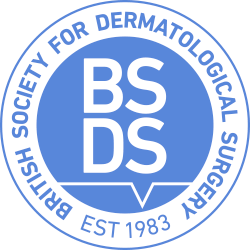Complications of Skin Surgery
Complications and their Prevention
• The first law of the universe – don’t panic.
• Prevention is much better than cure: facilities must be adequate. This includes personnel as well as equipment.
• Assess before operating, i.e., choose your patients wisely. Factors of importance include age, general fitness and drugs, including Aspirin. Discretion, not boldness, is the best guide.
• Plan everything – study anatomy, study procedure. Discuss procedure with patient.
Sedation –
The best and safest sedative with fewer side effects is the human voice. Firm pleasant tones and confident demeanour are far better than intravenous Diazepam. Pleasant, light background music is definitely helpful and widely used by dermatological surgeons in the United States.
Never work alone but remember that your discretion and skill must be matched by that of your colleague or nurse. Sudden in drawings of the breath as you slice through the facial nerve or “oh, my Gods” should be actively discouraged.
Bleeding –
This can be intraoperative or post-operative. You should have taken a history of any bleeding tendency and whether aspirin has been consumed in the 48 hours before surgery. During operation suction and diathermy are your best friends. Post-operatively firm pressure, slings for hands and arm wounds and elevation of leg wounds, together with avoidance of bending and stooping for facial and scalp wounds, will be helpful. Again, Aspirin should be avoided for at least 48 hours, as should alcohol.
Dissecting errors
Nerves –
These are the most important, particularly motor nerves. There are certain danger areas – posterior triangle of the neck (spinal accessory nerve). This innervates the trapezius and damage may lead to permanent dropped shoulder. The branches of the facial nerve, especially the mandibular branch as it emerges from the anterior edge of the parotid gland and superficial temporal branch as it crosses the zygoma. The common peroneal nerve in the lateral popliteal space as it gives rise to the superficial peroneal nerve. If these nerves are accidentally severed they should be repaired, if necessary, by a plastic or neurosurgeon.
Arteries and Veins –
of any size should also not be cut unless absolutely necessary. Badly planned incisions can give rise to unpleasant scars and keloids. Again, this all comes down to careful planning and study of the anatomy before operation.
Infection –
The rule is to get the antibiotic into the tissues before the knife if there is the likelihood of infection. You can gauge this simply by looking at the surface carefully before operating; if the surface is broken almost certainly staph aureus will be around and should be dealt with.
Dehiscence –
This is caused by a) infection b) excessive tension c) poor stitch craft or possibly omitting a necessary deep layer or sutures going through the dermal collagen. Bad scars and keloids may also be caused by the same factors, i.e. Infection, tension and wrongly placed incisions. Do not be guided by Langer’s lines but by crease marks, demonstrated by manipulating the skin prior to injecting local anaesthetic.
